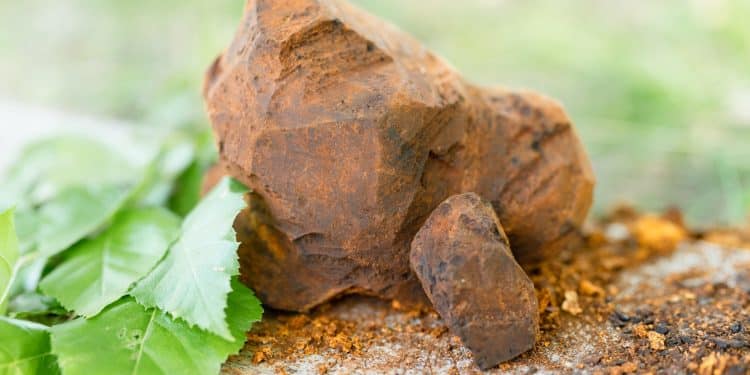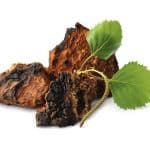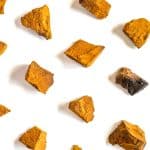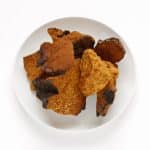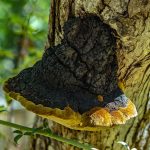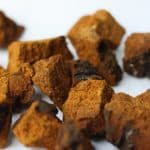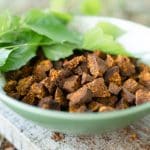As the myriad benefits of functional mushrooms continue to unravel, you might be surprised to hear that Chaga, the dark, charcoal-like lump, can support your skins appearance and health. Found growing on Birch trees at high latitudes across the northern hemisphere, the fungus has widespread nature, having been used for centuries medicinally across Russia, Japan, China, Korea, and Northern America.
Inonotus obliquus, or Chaga, looks much different than your average mushroom. In fact, that big black knob sticking out from a Birch Trees trunk is actually a type of Sclerotia. Inside its black, ridged outer surface is a bronzed mass of compacted mycelium.
If you are intrigued by this medicinal mushrooms “ugly duckling” and wondering how it might affect beauty, keep reading for more on the benefits that Chaga has on your skin, hair, and nails.
5 Chaga Benefits for Skin, Hair, and Nails
Although we might take this for granted, skin and its derivates (hair and fingernails) form the integumentary system, the largest organ of the body. Our skin acts as a barrier, keeping our tissues, organs, and bodily fluids in, and protecting us from external influences, including toxins and pathogens. It is our first line of defense against pathogenic bacteria, viruses, and fungi, but it also protects us against sun exposure, environmental pollutants, and dehydration. When applied topically, chaga can provide moisturizing and skin-lightening benefits.
Is Chaga Mushroom Anti-Aging?
UV light from the sun is a major contributor to premature skin ageing through collagen degradation or decreased synthesis. Chaga’s antioxidant, anti-inflammatory, and photoprotective properties could all have implications on skin aging. Laboratory experiments on human skin cells indicate that the phenolic acids could ameliorate and improve the wrinkling caused by UV radiation. So chaga does help with wrinkles and is anti-aging in that regard.
Chaga May Ease Skin Inflammation
There are historical records that record Alaskan Native American tribes using chaga to treat skin irritation. By decreasing irritation and inflammation, the anti-inflammatory properties of chaga can aid in combating breakouts.
Chaga Helps Calm Skin Sensitivities
The anti-inflammatory and immune-modulating properties of Chaga can decrease the skins sensitivities to allergies, strengthening the body’s natural immune system and improving resistance to environmental triggers like allergies that cause rashes or skin infections like tinea.
May Support Immune Health
The polysaccharides in Chaga helps to maintain a healthy immune system. This is particularly important to your skin, since it acts as a protective barrier against infectious germs.
Chaga Has Nutrients that Help the Skin, Hair, and Nails
Like other superfood mushrooms, chaga contains many nutrients, including amino acids that create proteins, B vitamins, minerals, and a variety of bioactive substances. The very components that helped chaga survive harsh conditions can support and strengthen your skin, hair, and nails.
Chaga’s Incredible Antioxidant Potential
Chaga grows in the north, where it is extremely cold. It is particularly prevalent in Siberia and Canada. Scientists speculate that Chaga evolved such an array of bioactive compounds in order to survive in its harsh environments. With regular consumption, these bioactive substances enable the benefits of chaga to be enjoyed.
Many of our bodies normal cell functions create free radicals, which are unpaired electron-atoms, molecules, or ions. According to the Free Radical Research, Reactive Oxygen Species (ROS), one kind of free radical, causes tissue damage and disturbs the body’s homeostatic equilibrium. Oxidative stress caused by excess amounts of free radicals may contribute to a number of inflammatory health conditions, including atherosclerosis, diabetes, and autoimmune diseases, and it can also be a contributing factor in aging.
Research suggests natural, non-toxic, dietary antioxidants, such as those found in chaga, can help to decrease oxidative damage to bodily tissues by preventing ROS formation, scavenging them, and contributing to their breakdown. As an antioxidant food, chaga has one of the highest values for oxygen radical absorbance capacity (ORAC). Chaga’s benefits to the skin and other tissues are thought to potentially result from synergistic effects from the multiple bioactive compounds working together.
Melanin is a pigment found in almost every animal. In Chaga and other mushrooms, melanin helps the organism to survive a harsh environment. In humans, it is the pigment in our skin that helps determine our skin color and tone, providing protection from harmful UV radiation from the sun. Laboratory studies show melanin in chaga has anti-oxidant and DNA-protective powers.
Terpenics and Phenolics
When isolated from chaga, these compounds demonstrate antioxidant and prebiotic activities in laboratory studies. Superoxide dismutase, catalase, and glutathione peroxidase, three powerful enzymes found in chaga, play significant roles in protecting cells against oxidative stress. Studies of the biomass form of chaga, which contains the mycelium and primates, have shown it to contain abundant enzymes and antioxidants that can deactivate ROS. Because it is in biomass form, rather than cell extract, the immune-boosting compounds are left active because they are resistant to denatured by digestive enzymes.
So Is Chaga Mushroom Good for Your Skin?
With all the evidence presented above, from reducing wrinkles, preventing inflammation, and helping with skin sensitivities, Chaga mushroom is absolutely fantastic for your skin.
Additional Resources:
